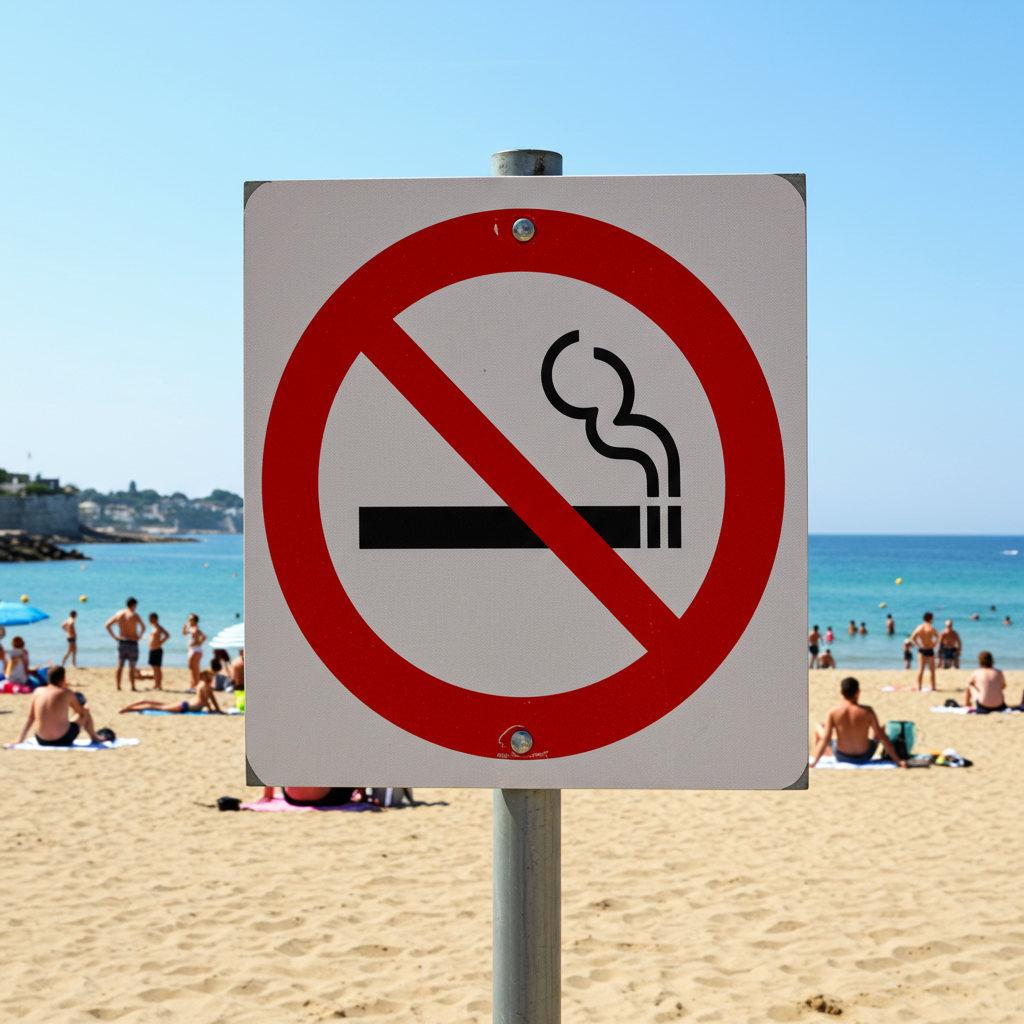France is stepping up its fight against tobacco, enacting strict new rules that prohibit smoking in a wide range of public outdoor spaces. Effective immediately, lighting up on beaches or in public parks across the country is now against the law. This marks a significant expansion of France’s anti-smoking efforts, aiming to protect citizens, especially children, from the dangers of passive smoke and move towards a future free from tobacco dependence. The measure reflects a growing global trend towards stricter public health policies surrounding smoking.
New French Public Smoking Restrictions Take Effect
As of Sunday, June 29, 2025, France officially banned smoking in numerous public outdoor locations nationwide. A decree published in the official government gazette made the new rules legally binding. This means anyone caught smoking on a beach or in a public park is now in violation of the law. The timing, just one week before the start of France’s school holidays, was strategic, designed to immediately shield children enjoying time outdoors.
The prohibition extends beyond just beaches and parks. It also covers areas around public facilities frequented by minors. Specifically, smoking is now forbidden within a 10-meter (approx. 33 feet) radius of schools, libraries, swimming pools, and bus shelters. The health ministry has indicated that official signage to clearly mark these restricted zones will be introduced soon.
Penalties for Violating the Ban
France isn’t just asking smokers nicely; there are real consequences for breaking the new rules. Individuals caught smoking in the designated banned areas face potential fines. While initial enforcement might include a grace period, the standard penalty for a violation is 135 euros (approximately $160 USD). However, the maximum fine for non-compliance can reach up to 700 euros. This financial deterrent underscores the seriousness of the new legislation.
Why France is Banning Outdoor Smoking
The primary motivation behind the expanded ban is public health, particularly protecting children. Health and Family Minister Catherine Vautrin emphasized this point, stating that places where children gather – like parks, beaches, and schools – should be free from tobacco smoke. These are spaces for playing, learning, and breathing clean air, not for smoking.
The new restrictions are also a key component of France’s ambitious national strategy to achieve a “tobacco-free generation” by the year 2032. Limiting visibility and accessibility of smoking in public spaces is intended to “denormalize tobacco,” making it less appealing, particularly to young people. Beyond health, the ban also addresses environmental concerns, specifically reducing the pollution caused by discarded cigarette butts on beaches and in parks.
Scope and Criticisms: What’s Still Allowed?
Despite being the most extensive outdoor smoking ban in France to date, the new rules do not cover all public spaces. A notable exemption is the outdoor seating areas of bars and restaurants, commonly known as terraces. Smoking remains permitted on these terraces, which are popular social spots across France.
This exclusion has drawn criticism from anti-tobacco activists. Groups like the National Committee Against Smoking (CNCT) view the ban as a positive “step in the right direction” but deem it “insufficient” because children also frequent cafe terraces and are still exposed to passive smoke there.
Adding to activist disappointment is the ban’s explicit exclusion of electronic cigarettes and vaping devices. Critics argue that the flavors used in e-cigarettes are designed to attract and “hook young people.” Pulmonologist and CNCT president Yves Martinet advocated for a broader measure covering all products containing tobacco or nicotine in public spaces for true effectiveness.
Hospitality Sector Concerns
The hospitality industry has voiced concerns about the potential impact of extending the ban to cafe terraces. Representatives like Frank Delvau of the UMIH for the Paris region suggest that banning smoking on terraces would merely relocate smokers to areas immediately adjacent to establishments, potentially causing different issues. Franck Trouet of the GHR association argued that terraces are among the “last places of conviviality and freedom” where smokers and non-smokers can coexist. This highlights the tension between public health goals and the social and economic aspects of French cultural life tied to cafe terraces.
The Public Health Burden of Smoking in France
Official data starkly illustrates the health costs associated with smoking in France. Passive exposure to tobacco smoke alone is estimated to cause a significant number of deaths annually, ranging from 3,000 to 5,000. Overall, smoking is responsible for a staggering 75,000 deaths each year in the country.
Beyond the human cost, smoking imposes a massive financial burden on society. The France addiction agency (OFDT) estimates the annual societal cost at a monumental 156 billion euros. This figure encompasses a wide range of factors, including lost lives, reduced quality of life, decreased productivity, prevention efforts, law enforcement expenses, and healthcare costs.
Declining Prevalence and Public Support
Despite the significant health burden, France has seen a steady decline in smoking rates over recent years. The OFDT reported that daily smoking prevalence in France reached its lowest level since 2000 in 2023. Less than a quarter of adults aged 18 to 75 reported smoking daily.
Public opinion appears to largely support further restrictions on smoking in public places. A recent survey indicated that 62% of French citizens favor such bans. This public backing provides a mandate for the government’s actions, aligning policy with the desires of a majority of the population.
France’s Broader Anti-Tobacco Efforts
The new outdoor ban is the latest measure in a series of policies France has implemented to curb tobacco use. Since 2007, smoking has been banned in all enclosed public places like offices and restaurants. In February 2025, France became the second European country to ban disposable e-cigarettes, following Belgium.
France’s approach aligns with a broader trend across Europe and globally. Countries like Sweden, Spain, and Italy have also expanded smoking prohibitions outdoors. There are also discussions at the EU level about potential recommendations for further restrictions, potentially including nicotine-free products.
The concept of a “tobacco-free generation” is gaining international traction. The UK, for instance, is considering legislation that would make it permanently illegal for anyone born after a certain date to purchase tobacco. While New Zealand previously enacted a similar generational ban that was later repealed, the global movement indicates the direction future tobacco control policies may take. France’s 2032 target positions it among the nations pushing for this long-term goal.
While the government is not currently planning new cigarette tax increases, partly to avoid fueling the black market, future measures could include restrictions on nicotine levels and vape flavors. The long-term impact of these cumulative bans on public behavior and culture, especially regarding the enduring association of smoking with French identity, remains a subject of ongoing observation and debate.
Frequently Asked Questions
What specific locations are included in France’s new public smoking ban?
The new nationwide ban effective from Sunday, June 29, 2025, prohibits smoking on all beaches and in public parks. Additionally, it bans smoking within a 10-meter (approximately 33 feet) radius of schools, libraries, swimming pools, and bus shelters. These measures aim to particularly protect children from passive smoke exposure in places where they play and gather.
Why does the French smoking ban not include cafe terraces or e-cigarettes?
The government has stated that the ban targets specific public areas for health protection, particularly for children. However, cafe terraces were excluded, with hospitality representatives arguing for them as spaces of coexistence and freedom, and suggesting a ban would just shift smokers elsewhere. E-cigarettes were also explicitly excluded from this specific ban, although anti-tobacco activists criticize this, arguing flavors target youth and passive vaping effects are not fully understood.
What are the penalties for smoking in banned areas in France?
Individuals found smoking in public spaces covered by the new ban, such as beaches, parks, or within 10 meters of schools and libraries, face financial penalties. The standard fine for violating the ban is 135 euros (about $160 USD). The maximum penalty for non-compliance can be as high as 700 euros.
Conclusion
France’s new comprehensive ban on smoking in public parks and beaches, alongside restricted zones near schools and other facilities, marks a significant advancement in the country’s public health strategy. Driven by the goal of creating a “tobacco-free generation” by 2032 and protecting children from passive smoke, this legislation reflects a firm commitment to reducing tobacco’s impact. While areas like cafe terraces and e-cigarettes remain exempt, drawing criticism from some health advocates, the move aligns France with international trends towards stricter tobacco control. The success of the ban will depend on enforcement, public acceptance, and potentially further measures to address remaining areas of concern and tackle the societal costs associated with smoking.



